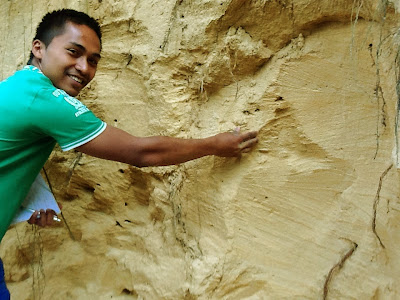Yesterday we started our day by handing out hardcopies of relevant maps (geology, topography) to the four groups. Then we went to get the rental cars with the student drivers in Aveiro, did not succeed in one go because some cars had only been booked for pickup after 12 a.m., bummer. Returned to the house and proceeded to discuss the general geological history of the area in the backyard of the house. This included the opening of the Atlantic Ocean, subsequent forming of a sedimentary basin, sedimentary rock types, metamorphosis, mineral composition of granites from the Serra da Estrela, stratigraphy, and so on. That gave them something to chew on. Then at 12 back to Avis Aveiro for pick-up of the last two cars. With everybody happy (and some people cooking) we finally started the excursion at 1 pm.
 |
| Upper Cretaceous C5 formation (60 million years old) near Bustos |
First stop, a clay pit with exposed clay layers of the 70 million year old Upper Cretaceous C5 formation (Maastrichtian - Campanian stages for the geologists), where we measured the very low apparant resistivity of the clays with our geophysical equipment, as well as the electrical conductivity of the lake water.
 |
| Measuring the resistivity of the clay (3 ohmm) |
 |
| and the conductivity of the lake water... |
We also did a clay tasting session (yes, we did put it in our mouth) and noted that there was sand in the clays because of the noises made when you chewed on it.
Then on to the second point of the excursion, travelling back several million years in geologic time to the Upper Cretaceous C3-4 formation (Turonian - Coniacian series) overlain by recent Quaternary deposits near the town of Mamarossa.
 |
| Discussing the Cretaceous C3-4 formation, overlain by Quaternary sands and beautiful heather plants |
Even further back in time to the C3 formation (Cenomanian stage) near the hamlet of Malhado do Baixio. This is a place where you can see life in the Cretaceous as there are lots of fossil shells and animal burrows (holes made by burrowing animals, such as crabs, in shallow water that were later filled up with sediments).
 |
| Small 80 million year old fossils in a Cretaceous rock. These happy little creatures lived in a shallow sea and never feared ending up for dinner on someones plate... |
There is also a clearly visible fault that cuts of the limestone banks, and vineyards for those who have a taste for wine.
 |
| Looking at fossils and rocks of the C3 formation |
Now to the lowest part of the Upper Cretaceous, the coarse-sandy C1-2 formation (Aptian - Albian stages). Here you can see that the granites from the Serra da Estrala supplied all the sediment, with quartz, feldspar grains and mica clearly visible in the layers. This is also the layer where the public water supply gets its high-quality drinking water from.
 |
| Looking at the Cretaceous C1-2 formation |
 |
| Emiel and Abdi looking at the Muscovite - mica layer |
 |
| Get bling-bling hands by rubbing mica!!! The latest trend... |
 |
| Group 2012 in the Cretaceous. |
|
To end the excursion we went to modern deposits near the Rio Boco catchment outlet. There are yellow-red Quaternary river deposits on top of the Cretaceous clays causing a contact spring to develop along the road.
 |
| Searching for cross-bedding in the Quaternary sands |
 |
| Donovan with cross-bedding |
That ended the excursion and covered most of the geology of our study area. So, at 7:30 pm, off to the supermarket to do shopping for dinner. Tchau!












No comments:
Post a Comment